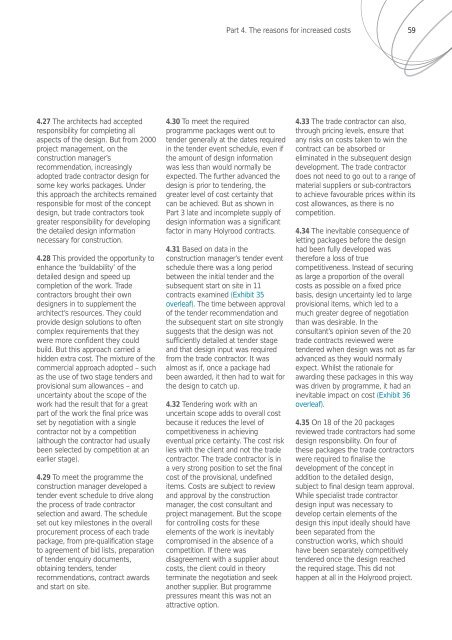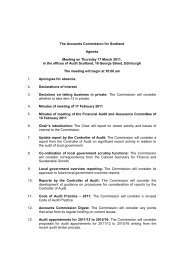Management of the Holyrood building project (PDF ... - Audit Scotland
Management of the Holyrood building project (PDF ... - Audit Scotland
Management of the Holyrood building project (PDF ... - Audit Scotland
Create successful ePaper yourself
Turn your PDF publications into a flip-book with our unique Google optimized e-Paper software.
4.27 The architects had accepted<br />
responsibility for completing all<br />
aspects <strong>of</strong> <strong>the</strong> design. But from 2000<br />
<strong>project</strong> management, on <strong>the</strong><br />
construction manager’s<br />
recommendation, increasingly<br />
adopted trade contractor design for<br />
some key works packages. Under<br />
this approach <strong>the</strong> architects remained<br />
responsible for most <strong>of</strong> <strong>the</strong> concept<br />
design, but trade contractors took<br />
greater responsibility for developing<br />
<strong>the</strong> detailed design information<br />
necessary for construction.<br />
4.28 This provided <strong>the</strong> opportunity to<br />
enhance <strong>the</strong> ‘buildability’ <strong>of</strong> <strong>the</strong><br />
detailed design and speed up<br />
completion <strong>of</strong> <strong>the</strong> work. Trade<br />
contractors brought <strong>the</strong>ir own<br />
designers in to supplement <strong>the</strong><br />
architect’s resources. They could<br />
provide design solutions to <strong>of</strong>ten<br />
complex requirements that <strong>the</strong>y<br />
were more confident <strong>the</strong>y could<br />
build. But this approach carried a<br />
hidden extra cost. The mixture <strong>of</strong> <strong>the</strong><br />
commercial approach adopted – such<br />
as <strong>the</strong> use <strong>of</strong> two stage tenders and<br />
provisional sum allowances – and<br />
uncertainty about <strong>the</strong> scope <strong>of</strong> <strong>the</strong><br />
work had <strong>the</strong> result that for a great<br />
part <strong>of</strong> <strong>the</strong> work <strong>the</strong> final price was<br />
set by negotiation with a single<br />
contractor not by a competition<br />
(although <strong>the</strong> contractor had usually<br />
been selected by competition at an<br />
earlier stage).<br />
4.29 To meet <strong>the</strong> programme <strong>the</strong><br />
construction manager developed a<br />
tender event schedule to drive along<br />
<strong>the</strong> process <strong>of</strong> trade contractor<br />
selection and award. The schedule<br />
set out key milestones in <strong>the</strong> overall<br />
procurement process <strong>of</strong> each trade<br />
package, from pre-qualification stage<br />
to agreement <strong>of</strong> bid lists, preparation<br />
<strong>of</strong> tender enquiry documents,<br />
obtaining tenders, tender<br />
recommendations, contract awards<br />
and start on site.<br />
Part 4. The reasons for increased costs 59<br />
4.30 To meet <strong>the</strong> required<br />
programme packages went out to<br />
tender generally at <strong>the</strong> dates required<br />
in <strong>the</strong> tender event schedule, even if<br />
<strong>the</strong> amount <strong>of</strong> design information<br />
was less than would normally be<br />
expected. The fur<strong>the</strong>r advanced <strong>the</strong><br />
design is prior to tendering, <strong>the</strong><br />
greater level <strong>of</strong> cost certainty that<br />
can be achieved. But as shown in<br />
Part 3 late and incomplete supply <strong>of</strong><br />
design information was a significant<br />
factor in many <strong>Holyrood</strong> contracts.<br />
4.31 Based on data in <strong>the</strong><br />
construction manager’s tender event<br />
schedule <strong>the</strong>re was a long period<br />
between <strong>the</strong> initial tender and <strong>the</strong><br />
subsequent start on site in 11<br />
contracts examined (Exhibit 35<br />
overleaf). The time between approval<br />
<strong>of</strong> <strong>the</strong> tender recommendation and<br />
<strong>the</strong> subsequent start on site strongly<br />
suggests that <strong>the</strong> design was not<br />
sufficiently detailed at tender stage<br />
and that design input was required<br />
from <strong>the</strong> trade contractor. It was<br />
almost as if, once a package had<br />
been awarded, it <strong>the</strong>n had to wait for<br />
<strong>the</strong> design to catch up.<br />
4.32 Tendering work with an<br />
uncertain scope adds to overall cost<br />
because it reduces <strong>the</strong> level <strong>of</strong><br />
competitiveness in achieving<br />
eventual price certainty. The cost risk<br />
lies with <strong>the</strong> client and not <strong>the</strong> trade<br />
contractor. The trade contractor is in<br />
a very strong position to set <strong>the</strong> final<br />
cost <strong>of</strong> <strong>the</strong> provisional, undefined<br />
items. Costs are subject to review<br />
and approval by <strong>the</strong> construction<br />
manager, <strong>the</strong> cost consultant and<br />
<strong>project</strong> management. But <strong>the</strong> scope<br />
for controlling costs for <strong>the</strong>se<br />
elements <strong>of</strong> <strong>the</strong> work is inevitably<br />
compromised in <strong>the</strong> absence <strong>of</strong> a<br />
competition. If <strong>the</strong>re was<br />
disagreement with a supplier about<br />
costs, <strong>the</strong> client could in <strong>the</strong>ory<br />
terminate <strong>the</strong> negotiation and seek<br />
ano<strong>the</strong>r supplier. But programme<br />
pressures meant this was not an<br />
attractive option.<br />
4.33 The trade contractor can also,<br />
through pricing levels, ensure that<br />
any risks on costs taken to win <strong>the</strong><br />
contract can be absorbed or<br />
eliminated in <strong>the</strong> subsequent design<br />
development. The trade contractor<br />
does not need to go out to a range <strong>of</strong><br />
material suppliers or sub-contractors<br />
to achieve favourable prices within its<br />
cost allowances, as <strong>the</strong>re is no<br />
competition.<br />
4.34 The inevitable consequence <strong>of</strong><br />
letting packages before <strong>the</strong> design<br />
had been fully developed was<br />
<strong>the</strong>refore a loss <strong>of</strong> true<br />
competitiveness. Instead <strong>of</strong> securing<br />
as large a proportion <strong>of</strong> <strong>the</strong> overall<br />
costs as possible on a fixed price<br />
basis, design uncertainty led to large<br />
provisional items, which led to a<br />
much greater degree <strong>of</strong> negotiation<br />
than was desirable. In <strong>the</strong><br />
consultant’s opinion seven <strong>of</strong> <strong>the</strong> 20<br />
trade contracts reviewed were<br />
tendered when design was not as far<br />
advanced as <strong>the</strong>y would normally<br />
expect. Whilst <strong>the</strong> rationale for<br />
awarding <strong>the</strong>se packages in this way<br />
was driven by programme, it had an<br />
inevitable impact on cost (Exhibit 36<br />
overleaf).<br />
4.35 On 18 <strong>of</strong> <strong>the</strong> 20 packages<br />
reviewed trade contractors had some<br />
design responsibility. On four <strong>of</strong><br />
<strong>the</strong>se packages <strong>the</strong> trade contractors<br />
were required to finalise <strong>the</strong><br />
development <strong>of</strong> <strong>the</strong> concept in<br />
addition to <strong>the</strong> detailed design,<br />
subject to final design team approval.<br />
While specialist trade contractor<br />
design input was necessary to<br />
develop certain elements <strong>of</strong> <strong>the</strong><br />
design this input ideally should have<br />
been separated from <strong>the</strong><br />
construction works, which should<br />
have been separately competitively<br />
tendered once <strong>the</strong> design reached<br />
<strong>the</strong> required stage. This did not<br />
happen at all in <strong>the</strong> <strong>Holyrood</strong> <strong>project</strong>.

















